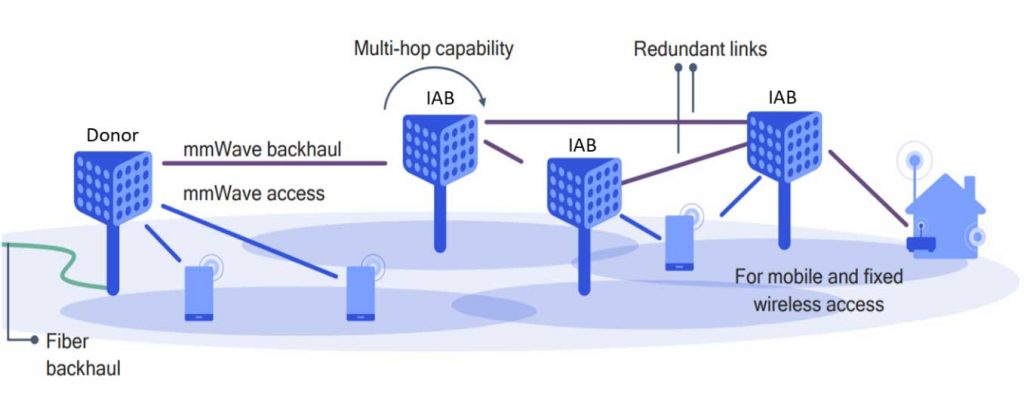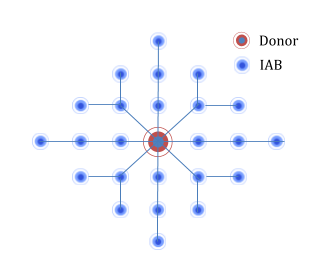27
Jul
IAB–the cost-effective solution to quickly expand 5G mmWave coverage

One of the exciting features the recently finalized 3GPP Rel. 16 brings to 5G is the support for Integrated Access Backhaul (IAB). IABs have the potential to be a game-changer, especially for millimeter Wave (mmWave) deployments by solving the key challenge of backhaul. However, the traditional design of IABs offers low efficiency. In this article, I will take a deep dive into IABs, their deployment configurations, and most importantly, the techniques needed to improve their efficiency.
Side Note: If you would like to learn more about 3GPP Rel. 16, check out this article “3GPP Rel. 16–Stage set for the next phase of 5G, but who is leading?”
What are IABs and how do they work?
IABs are cell sites that use wireless connectivity for both user traffic (access) as well as backhaul. IAB’s predecessor— relays—have been around since 4G days. IABs are essentially improved and rechristened relays. If you have heard of Sprint “Magic Box,” then you have already heard about relays and to some extent IABs as well.
So far, relays were used primarily to extend coverage in places where it was challenging or uneconomical to deploy traditional base stations with fiber or ethernet backhauls. They were also useful when connectivity needs were immediate and temporary. A great use case was the recent COVID-19 crisis when temporary healthcare facilities with full connectivity had to be built very quickly. There are many such applications, for example, indoor deployments in retail stores, shopping malls, etc., where operators do not have access to fiber.
However, with expanded capabilities, IABs have a much bigger role to play in 5G, especially for mmWave deployments who have gotten a bad rap for having smaller coverage footprint. IABs allow operators to rapidly deploy mmWave sites and expand coverage by solving the teething backhaul issue.
IABs are deployed just like any other mmWave sites, of course without requiring pesky fiber runs. As shown in the figure below, IABs connect to donor sites in the same way as smartphones or any other devices. The main donor sites will need high capacity fiber backhaul. One or more IABs can connect to a single donor site. There could be multi-hop deployments, meaning IABs could also act like donors to other IABs. Each IAB could connect to multiple sites or IABs, providing redundancy. This configuration lends itself very well for mesh architecture in the future as well. IABs are transparent to devices, meaning devices connect to IABs just as they would to any regular base stations.
 IABs are ideal for mmWave deployments
IABs are ideal for mmWave deployments
As I had explained in my previous article, mmWave 5G deployments need a dense cluster of sites to provide good outdoor coverage. Since bringing backhaul to all these sites is cumbersome and expensive, using IABs for such deployments is ideal. For example, in city centers, there could be a handful of donor sites with fiber backhaul, connecting to clusters of IABs around them. As evident, with such approach operators could provide much broader coverage with much fewer fiber runs, in a very short time. The savings and ease of installation are quite obvious.
It should be noted that unlike regular sites, IABs do not add new capacity. They instead share the capacity of the donor site much more efficiently across a much larger coverage area. Since the mmWave band has lots of spectrum, capacity may not be a limitation. Ultimately, the level of data traffic and the amount of spectrum operators have access to will decide the appropriate mix of donor sites and IABs.
One of the issues with IABs is interference. Since donors and IABs use the same spectrum, they might interfere with each other. But thanks to the smaller coverage footprint of mmWave bands, the interference is relatively minimal, compared to traditional bands. Another big advantage of mmWave bands is the support for beamforming and beamsteering techniques. These techniques allow the signal (beam) between all the nodes to be very narrow and highly directional, which further reduces interference.
Performance challenges of IABs
The biggest challenge of IABs is their lower efficiency. Since they use the wireless link for both sides (towards donor and user), they have to either use a separate spectrum or time-share between the sides. In both cases, efficiency is reduced, as the first case uses twice the spectrum, and the latter allows only one side to be active at any time. Let me explain, reasons for it.
If the same spectrum is used for both sides, there will be huge self-interference, meaning the transmitter from one side feeds into the receiver of the other side making interference so high that signal from actual users is drowned out and can’t be heard. So, the spectrum for both sides must be different. Since operators are often short on spectrum, they cannot afford this configuration. Even if they could, there are many complexities, such as requiring frequency planning, inability to support mobile IABs, confusion in handover between the two frequencies, and many more.
Hence, almost every deployment utilizes an alternate approach called Half-Duplex, in which the sides are tuned ON alternatively. The IAB ON/OFF timing has to be synchronized across the network to avoid interference. The situation is even more complicated if there are multi-hop deployments.
 The best way to understand the performance of IABs is to simulate a typical system and analyze various scenarios. Kumu Networks, a leader in relay technology, did exactly that. Here is a quick overview of what they found out.
The best way to understand the performance of IABs is to simulate a typical system and analyze various scenarios. Kumu Networks, a leader in relay technology, did exactly that. Here is a quick overview of what they found out.
They simulated a typical city intersection, as shown in the figure here. They put a fiber-fed donor at a city intersection and a cluster of IABs along the streets, some connected directly, others in multi-hops. The aggregate throughput is calculated for the entire system with one, two, and multiple hops.
Image courtesy of Kumu Networks.

